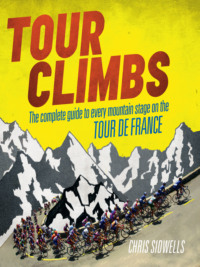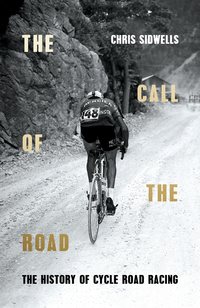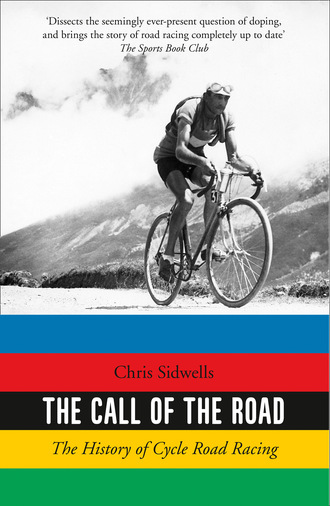
Полная версия
The Call of the Road

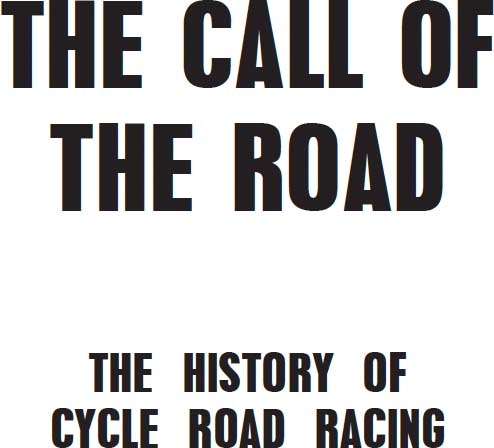

Copyright
William Collins
An imprint of HarperCollinsPublishers
1 London Bridge Street
London SE1 9GF
WilliamCollinsBooks.com
First published in Great Britain by William Collins in 2018
This William Collins eBook edition published in 2019
Copyright © Chris Sidwells 2018
Images © Individual copyright holders
Cover photograph © ullsteinbild/Getty Images
Chris Sidwells asserts the moral right to be identified as the author of this work in accordance with the Copyright, Designs and Patents Act 1988
A catalogue record for this book is available from the British Library
All rights reserved under International and Pan-American Copyright Conventions. By payment of the required fees, you have been granted the non-exclusive, non-transferable right to access and read the text of this e-book on screen. No part of this text may be reproduced, transmitted, down-loaded, decompiled, reverse engineered, or stored in or introduced into any information storage and retrieval system, in any form or by any means, whether electronic or mechanical, now known or hereinafter invented, without the express written permission of HarperCollins.
Source ISBN: 9780008220808
Ebook Edition © 2019 ISBN: 9780008220785
Version: 2019-04-17
‘An intriguing read for almost any reader, not only those who are interested in cycling’
Tuam Herald
‘[An] engaging and accessible account of the race’s history’
Sunday Business Post
‘The Call of the Road is the definitive story of cycle road racing … Sidwells dissects the seemingly ever-present question of doping, and brings the story of road racing completely up to date’
The Sports Book Club
Contents
Cover
Title Page
Copyright
Praise
1 Call of the Road
2 The First Road Races
3 The Tour is Born
4 Racing Into the Sky
5 Growing the Roots of Tradition
6 The Freelancers
7 Rainbow, Yellow, Pink and Polka-dot
8 Women’s Road Racing
9 Behind the Iron Curtain
10 The Great British Anomaly
11 Brentry, Britain Joins Cycling’s EU
12 Time Lords and Ladies
13 D is for Domestique
14 E is for Echelon
15 Round the Houses
16 Aussie Roules
17 American Flyers
18 The Greatest
19 Dark Side of the Road
Picture Section
Index
Acknowledgements
About the Author
Also by Chris Sidwells
About the Publisher
1
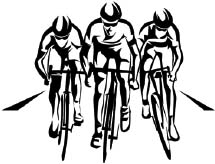
Call of the Road
A road race is many things. It includes many aspects of life, but magnified; a maelstrom of ambitions, plans, desire, cooperation and treachery. A road race ebbs and flows through the countryside like a living thing, a kaleidoscope of colour, a visceral mass of muscle and machine, a chess game played on wheels. And it doesn’t matter what level: whether it’s the Tour de France or evening league, road races share the same basic qualities. Only speed, distance, stakes and the sophistication of the game are different.
Road races are battles, pure battles where social norms are replaced by personal or cohort needs. Basic needs like food and drink to re-fuel and shelter to save energy, and higher needs like peer approval, money, victory and admiration. It’s rare to experience physical battles in everyday life, and on that level the fight to succeed brings out something primitive, making road racing wonderful to experience and wonderful to watch.
But the best professionals raise road racing to an art; the art of warfare maybe, the art of a hunter perhaps, but still art and glorious to behold and appreciate. Especially since road racing is not played out in stadiums or on pitches, but on incredible natural canvases. Some are stark, set on the cobblestone roads and brutish hills of northern Europe. Others are stunning, like races in the great mountain ranges of Italy, France and Spain. But all are beautiful in their unique way.
There are single-day road races and stage races. Some single-day races have more history or more notable terrain, and they are called the classics. Of the classics five are the biggest and the best, and they are known as the ‘monuments’ of cycling. Stage races are at least two or three days long, most are around one week, but the biggest stage races last for three weeks. They are the Grand Tours: the Giro d’Italia, the Vuelta a España, and the biggest and oldest of them all, the Tour de France.
The Tour de France is not just the biggest bike race in the world, it’s the biggest annual sports event in the world, only ever surpassed by football’s World Cup and the Olympic Games. Figures from 2011 show that the Tour de France, or simply the Tour as it’s referred to in cycling, was covered by seventy radio stations, four thousand newspapers and press agencies, and seventy websites, who between them sent 2,300 journalists from thirty-five countries to the race. The Tour de France website, www.letour.fr had 14 million unique visitors that year. Over 100 TV channels broadcast the race to 190 countries in 2011, sixty of them receiving live pictures. And that’s just the media coverage, which has grown since 2011; the Tour de France has a truly worldwide audience today.
The number of roadside spectators is harder to gauge, but the Tour organisers Amaury Sport Organisation (ASO) reckon that a staggering 12 to 15 million people watch the race pass by at some point each year. And that’s one of the big attractions of road racing: it goes to the places where people live, it comes down their roads and past their houses. Still, many spectators want to see the race on a famous mountain climb, and they must either walk or bike there on the day of the stage, or they must drive there two or three days beforehand to get any chance of finding a place to park. Many camp on the mountainside, turning their visit into a holiday.
By the time the race gets there the crowds on mountain roads are huge. Police estimated that half a million people stood on Alpe d’Huez to watch a time trial stage in 2004. The atmosphere is always electric and often a little bit mad. Some fans wear bizarre costumes, and so many spill out onto the road that the race leaders often face a wall of hysterical humanity, which parts just ahead of them, leaving only the narrowest gaps to ride through. It’s an incredible sight, and unforgettable to be part of. So let’s look at a typical mountain stage of the Tour de France.
The race fills almost any place where it starts or finishes. Parking anywhere near the start is impossible, so planning ahead is vital if you are to see anything. The focus is the Village de Départ, a temporary structure erected by a travelling team, then taken down as soon as the race leaves town, and transported to wherever it’s needed next.
In Tours gone by everybody had access to all areas, but the race has outgrown the charming informality it once had. Riders, race officials, accredited media and VIPs are the only people allowed in the Village now. Everybody else stands behind barriers, people-watching and star-spotting, and there are plenty of both to see. Old champions and former team-mates meet for a coffee in the Village, where they gossip about the old days; celebrities are shown around by sponsors or race officials, while members of the media pretend to check their smartphones but are continually looking for somebody, anybody, to interview. They don’t find many current riders, just the few who are sent out by their teams to keep the press happy.
The Tour de France has changed a lot. It was always big, always serious for the top riders, but now it’s very big and ultra-serious for every rider. Everybody takes their A-game to the Tour de France – they have to; anything less won’t do. Riders don’t mingle much with the public now; they are cocooned behind black glass in massive team buses. Inside they chat in air-cooled calm, or get lost in i-pods and laptops, but they are all focusing on the day ahead. The last team briefing is done. Everybody knows their job, their part in the team’s stage plan has been explained. This is their quiet time before battle.
Some of the more garrulous riders emerge from the buses first, sign autographs and pose for selfies. Some like the attention, the interaction, but they are rarely the contenders, who stay in their bus shells until the last minute. They want to avoid questions from news-hungry press. How do they feel? What do they think will happen today? Is this a crucial stage? Things the top guys know, or hope they know, but are unwilling to talk about because they don’t want input from anybody else, or in case they are just plain wrong. Contenders emerge in time to wave, nod politely at well-wishers, and head for the signing on. They have a job to do in the race, and it takes all they’ve got to do it. There’s no spare capacity to answer questions, not now, not before the stage. Afterwards they’ll talk at length.
Signing on for a stage is a cycling tradition. In days gone by it served to inform officials which riders were still in a race, but now it’s used as a device for the race speaker to introduce the riders to the spectators, so they know who is who and what they’ve won. One at a time the riders mount the steps to the speaker’s stage, walk stiffly to where they sign, wave to the crowd and by the time they’ve gone the speaker has been through their career in detail, and maybe had a word or two from them. The speaker never asks difficult questions, that’s his side of the bargain. It’s all done quickly and professionally, then the riders head for the start line and the race rolls out.
Tour de France stages have two starts; a nice smiley ceremonial one in the middle of town, then the real one when the race gets out in the countryside. The man in charge, the Tour de France director, the ultimate word on the race, Christian Prudhomme is driven ahead in a distinctive red car. The riders follow it closely, crowding its back bumper. Prudhomme emerges through the sun-roof, a red flag stretched between his hands. The riders watch it, waiting for him to drop it, and when he does all hell breaks loose.
The director’s car accelerates away, and the riders always attack. It’s like the cork coming out of a Champagne bottle, the start of each team’s stage plan, a release of pent-up energy as every rider is anxious to play his part. Tour stages need breakaways, more often referred to as breaks. On stages that suit sprinters their teams work to ensure the whole bunch is together for the finish, but part of doing that involves letting a group go ahead early and stay ahead for a while. The early attackers are trying to form such a breakaway.
In professional road races an early break creates order where otherwise there would be chaos. Breakaways provide a focus for the race; they give it shape so long as there’s nobody in them who threatens somebody else’s plan. Breakaways stop races becoming a free-for-all for the whole distance, with attack after attack until the peloton is cut to ribbons. The trick is not to let a breakaway get so far ahead it can’t be caught later. Just keep it there, keep the gap, then reel it in before the finish. Pro teams have that down to an art.
But this isn’t a sprinter’s stage, this is a mountain stage with other agendas going on. A breakaway still brings order, but the riders trying to get in today’s break come from two distinct groups. One is trying to win the stage, and the other is made up of riders trying to help their team leaders win the race overall. I’ll talk more about both groups in later chapters, but for now let’s look at how a breakaway forms at this level of racing.
For a start the other riders don’t say, ‘Go on, lads, you go ahead and we’ll see you later.’ Quite the opposite, and there’s an incredible scrap before a breakaway forms. Its mix must be right, and the other riders won’t let anything go until it is. For example, if an outside favourite for overall victory or a high overall placing tries to slip into a breakaway unnoticed, it won’t happen. It will be noticed, and the other teams will pounce on it and snuff it out.
Neither will the other favourites’ teams let one of their rivals get too many team-mates in a breakaway. If they did that, they could find themselves outnumbered later in a stage. So there will be attack and counter-attack, embryo breakaways forming and being brought back, until the right combination is allowed to go. Then things calm down, and the break is on.
But if all that sounds too choreographed, many things can spoil the script. Crosswinds, early steep climbs and other factors can and do upset the course of all the above. Early difficulties in a race provide opportunities for the strongest riders or teams to attack early and turn everything on its head. It happens a lot, especially in single-day races, but that’s another thing I’ll cover later in the book.
The British rider Steve Cummings is a current top dog at spotting the right combination of riders for a breakaway to succeed, and when a stage suits him he’ll be in it. ‘I focus totally on the first ninety minutes of a stage I know I can do well in,’ he says. ‘I don’t even think about the rest of it, I just psyche myself up for the first ninety minutes, because that’s when you have to give everything you’ve got to ensure you get in. Once I’ve done that, and I’m in, then I think about the rest of the stage.’
Cummings’s preference is for rolling terrain, or medium mountains in cycling parlance, a route with several quite long climbs, but not the big mountains of the Alps and Pyrenees. The stage I’ll try to describe here isn’t like that. It’s a typical, if imagined, stage in the Alps. One that finishes on top of one of the famous climbs: Alpe d’Huez, say, or the Col du Galibier.
Okay, on with the stage. Let’s say an early break has formed, so now the race leader’s team by tradition assumes control at the front of the peloton, trying to go fast enough to discourage further attacks but not so fast that the breakaway is caught early. If it is caught, the attacks will start all over again.
With the race leader’s team in control, the race is in perfect balance, and will stay that way for a while. Time to consider the physical presence of the Tour de France, because it’s immense. For a start there’s the Caravane Publicitaire, the procession of vehicles that precedes the riders, and it’s spectacular and weird in equal measure.
If you watch the Tour de France by the roadside – and everybody should do it once because it’s an incredible experience, very different from seeing the race on TV – the first race vehicles start zooming past you at least two hours before any cyclist is seen. They might be media or logistics vehicles on the way to the stage finish, vehicles involved with safety or official duties; cars, lorries, motorbikes and buses all zoom by. Then, after a short pause, the Caravane arrives.
Have you seen a giant fibre-glass insect lying on a flat-bed truck, or a man driving a huge gas canister or a giant wheel of cheese? Or have you been pelted with cheap plastic knick-knacks flung from a float by moonlighting students? Well you will; you’ll see them all, along with more elaborate creations, in the Caravane Publicitaire. All are products of the imaginations of publicists or design agencies, who embrace the maxim ‘weird is wonderful’, and weirder is always better for the Tour de France.
The Caravane takes forty-five minutes to pass. Some vehicles stop to better distribute their branded plastic tat, while those in others just chuck it in the direction of spectators as they drive by. Woe betide you if you try to race a French granny for a free Esso keyring. She will trample you down and her grand-kids will dance on your spine.
Once the Caravane has gone there’s another lull, an even shorter one punctuated by waves of motorbikes and cars, all part of the Tour, all speeding to where they are needed next. To marshal the race, maybe, or man one of the feed stations. They pass like squally showers, with an increasing number of French police connected to the race mixed in. Team vehicles too. Each passing batch is greeted with enthusiasm. Is this the race? Are the riders coming now? No. You can’t mistake it when they do.
First there’s a Mexican wave of noise. It’s been noisy so far but the noise has been random, without any order to it. This noise has order, and depth, and it grows louder and louder. On flat stages the noise travels from village to village towards you, drowning the throbbing of the helicopters above the race at first, but then they get too near to be drowned out. There are always at least two helicopters above the riders, swapping with others, leapfrogging to provide total stage cover for TV directors to switch to. Nothing is better than a view from above to show what’s happening in a road race.
You feel as well as hear the race long before you see it, but that feeling is magnified in the mountains. Go high and you might be standing directly above the race as it approaches. It ascends to you, passing thousands of spectators lining the route below you. The sound of their cheers and cries is trapped by the surrounding rocks and bounces off them, reverberating upwards. Alpe d’Huez, for example, is a natural theatre. The climb is named after a ski village at its summit, and it starts directly below the finish in Bourg d’Oisans. The road between the two places goes up in tier after tier, twenty-two hairpin bends and twelve straights, one piled on top of the other.
Standing, waiting for the race near the summit of Alpe d’Huez or Mont Ventoux, as I have done, the sound rises up to meet you, to engulf you. The helicopters fly slowly upwards, their blades beating the air, sending pulses of sound pushed by thousands of shouting, screaming voices, rolling upwards like thunder, charging the air so it prickles with anticipation.
The riders get nearer and nearer, clawing their way upwards like a giant bellowing beast. Nearer and nearer, our anticipation growing. Cars, motorbikes, police whistles, revving engines, shouting and screaming. A solid wave of sound crashing up a rocky wall, rolling onwards and upwards. The anticipation grows stronger and louder, until …
They’re here, the first riders, though you can’t see them yet because people further down the road have rushed out to see them before you do. The early breakaway has been caught, and now the best in the race are fighting it out for the stage. They include most of the overall contenders.
Anticipation turns into hysteria now, and formerly responsible people with good jobs and old enough to know better go glassy-eyed. They jump up and down, shouting themselves stupid. Kids grab their parents’ hands for reassurance. What’s happening? Now you can taste the Tour, it’s an actual physical thing, like a summer storm and the relief of rain.
People crowd the riders, some run alongside, roaring incoherently at them. They ignore everything that isn’t a clear threat, but fans who get too close risk a slap from their hero, and possible rough treatment from the rest of the crowd.
The stage leaders’ faces are masks of concentration. Only total commitment and solid self-belief keeps them where they are. Let go now, and it’s over. There’s a belief in pro road racing that everybody at the pointy end of a mountain stage in a Grand Tour is three minutes from letting go. That’s how they get through, they hold on for these three minutes, then the next three, and the next, and the three after that, until they cross the finish line or they cross their physiological and/or mental thresholds.
Then, one by one, riders let go. That’s what they call it. They say, ‘I had to let go’ or ‘I blew’ – another cycling word. The stage is over for them now, and all they can hope for is to limit their time losses.
Sometimes they lose ground slowly, agonisingly. They drop to the back of a group then fight forwards, drop back, then forwards again, then back until this time there’s a gap to the back of the group, and it grows bigger. Limitations accepted, they join the group behind, promising to challenge later. It’s not all over, they think. They will come back, they think. They seldom do, not at this stage. Others fail in a worse way. They go into the red, a zone of effort the body can’t maintain. It goes into oxygen debt, a debt that can only be repaid by slowing down. And if they stay too long in the red, and some can because toughness is high up on a pro road racer’s job description, they slow down rapidly and irretrievably.
All the above has played out on this final climb. We are three kilometres from the summit now. The front group of five looks good. Behind them more flog past where I stand, some don’t look so good, but others have found something; they are chasing, eyes full of hope and fixed ahead. Ones, twos, little groups and bigger groups, pass until the last big one, known as the auto-bus.
That’s where the sprinters live on mountain stages, helping each other get through and beat the time limit. It’s not easy, because their physiques, so powerful and so fast on the flat, work against them here, but they push on, trying as hard as the climbers at the front but with less encouragement.
The wave of emotion rolling up the mountain peaks with the passing of the first riders, then slowly ebbs away as the others pass. The sprinters get respect, they certainly deserve it, polite applause and encouraging words mostly. There’s occasional abuse too, but even the front riders can get that. It comes from people who should know better, and some do, but alcohol has turned off their inhibitions. Considering the millions of people they pass, the riders don’t get abused so much.
Up front the battle is on, war is being waged. Two kilometres to go now, and four riders are chasing one who has launched a decisive attack. Attacks must be 100 per cent, especially at this point in a stage. The best road racers in the world are fighting for the biggest road racing prize. Attacks in this company at this point must stick. If they fail, the rest will blow right by and the attacker will lose time, and probably any chance of winning the Tour de France this year.
But this attack looks good. This rider is on top of his game, at full stretch but totally in control, making a superhuman effort he can keep all the way to the finish line. His legs are on fire, but his will to win overrides them. Total concentration, his pain-face some call it, not strained, just set: a steely glare ahead. One kilometre to go, keep it going, this is good; this will work.
Push, push. At this point a rider might feel everything around him starting to fade. His peripheral vision is slowly fading, even the colours he sees become muted. His muscles are demanding so much oxygen that his body sends everything to them. His eyes can wait; his legs, lungs and heart can’t. They must have oxygen now.


